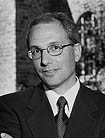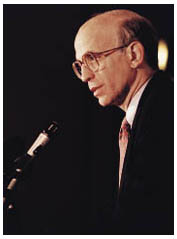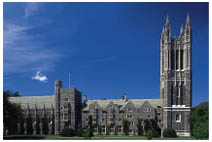Notebook - April 5, 2000
Size of faculty expected to grow
over the next decade
Some reallocation of positions will occur under Wythes Report recommendations
Big changes at the university will come if the Wythes Report is approved
by the Board of Trustees at its meeting on April 15. The most important
difference will be the planned 10 percent increase in the undergraduate
student body, a move that members of the Wythes Committee endorse, as do
many administrators, faculty, and parents of would-be Princetonians.
One of the reasons given in support of an increased undergraduate enrollment
is that over the last 20 years, the student to faculty ratio has shrunk
from around 8:1 to about 6.7:1, a ratio lower than that of any peer institution
and as low as Princeton strives for. For the university to increase the
ratio without adding students, the number of the faculty would have to decrease
over time.
By adding 500 students instead, the faculty will continue to grow at
its current rate.
"Our student/faculty ratio is now at an historic low," said
Dean of the Faculty Joseph H. Taylor, "which means we'd probably be
reducing new hires over the next 10 years, if not for the proposed influx
of new students. The additional 500 undergraduates allows us
to justify a con-tinued faculty growth of 1 percent a year-meaning we'll
be able to hire new professors in overcrowded departments as a result. Believe
me, there's no area in the university we want to do away with." In
the report, the dean estimated that "as many as 15 percent of all vacancies
that occur at the senior levels and approximately 10 percent of all vacancies
at the junior levels might be reallocated."
One measure Taylor uses to determine where additional faculty resources
should be concentrated, he said, is- roughly-the number of student concentrators
and course enrollments per full-time-equivalent faculty member.
Complicating the anticipated hiring is the charge from the Wythes Committee
to further diversify the ranks of the faculty. The wording in the committee's
report is specific: "The Committee supports aggressive efforts to increase
the diversity of the faculty. Progress has been made in recent years, but
Princeton remains quite far from the levels to which it can reasonably aspire
in some areas, given the talent available."
In a meeting of the Council of Princeton University on March 8, Taylor
acknowledged that the charge to diversify the faculty was important and
challenging, and he added that Princeton had had some successes and some
failures in that area. "We do not feel smug about where we are right
now in terms of diversity," he said. "We're going to double and
redouble our efforts."
Another point is the increasing age of the ranked faculty; currently
the average age is 53.74. "It's not surprising we're where we are,"
Taylor said regarding the average age. "We added faculty in the 1970s,
when we went coed."
The fraction of the ranked faculty (assistant professors, associate professors,
and professors) has also increased from two-thirds in 1976 to three-quarters
in 1998. "We'd like to push that down to about two-thirds," Taylor
said. "Our goal is to have the best possible mix across the educational
spectrum-including faculty members fresh out of grad school, who are most
likely to be exposed to the very latest thinking in their field, as well
as more established scholars and teachers."
If the trustees choose not to approve the recommendations of the Wythes
Report in April, their next opportunity will be at the June meeting.
Illuminating idea: Scientists create
a better display screen
Most laptop computers and cell phones feature a type of screen called
a flat-panel display, which is illuminated by liquid crystals (LCD). Most
desktop computers and televisions, in contrast, use a cathode ray tube (CRT)
illuminated by a beam of electrons. Recently, Princeton engineers combined
two types of molecules, fluorescent and phosphorescent, to create a new
illumination device called an organic light-emitting diode (OLED), which
is more energy efficient and provides a higher quality picture than either
liquid crystals or cathode rays.
Led by Professor of Electrical Engineering Stephen Forrest, the team
of scientists built on their 1998 discovery that phosphorescent molecules
can be coaxed to be efficient consumers of energy. Unfortunately, there
are relatively few phosphorescent materials with both good color quality
and long life spans. Combining fluorescence, which does come in a wide variety
of materials, with phosphorescence could produce a display that is brighter,
uses less electricity, offers truer colors, and allows a smaller pixel size.
The discovery of this extra-efficient OLED, a feat of engineering at
the level of quantum mechanics involving singlets and triplets (electrons
that are propelled away from the atom and give off light as they fall back),
brings the widespread use of flat-panel displays for electronic devices
that much closer to the market. The implication is that portable devices,
in particular, would draw less energy from a battery when fueled by OLEDs,
and that large electronic applicances would be less expensive to operate.
The university has applied for a patent for Forrest's work and has licensed
rights to the discovery to Universal Display Corporation, which is dedicated
to developing the display technologies from Forrest's lab and which partially
funded the research. Additional funding came from the Department of Defense,
the Air Force, and the National Science Foundation.
Justin Harmon '78 announces departure
for Wesleyan
Communications office loses two employees
 Justin Harmon '78, director of communications for the university for
the past 13 years, has accepted a newly created position at Wesleyan University.
He will oversee all communications-related activities at Wesleyan and be
a member of President Douglas J. Bennet's senior staff.
Justin Harmon '78, director of communications for the university for
the past 13 years, has accepted a newly created position at Wesleyan University.
He will oversee all communications-related activities at Wesleyan and be
a member of President Douglas J. Bennet's senior staff.
In addition to acting as the principal spokesperson for Princeton and
overseeing the university's publications, Harmon managed coverage of five
Nobel Prize announcements, hosted the White House press corps for speeches
by two U.S. presidents, and worked to improve the reportage of research
advances by Princeton faculty. He will join the Wesleyan administration
full time on May 1.
In addition to Harmon, the university is losing the editor of the Princeton
Weekly Bulletin, Sally Freedman, who announced plans to move to Vermont
with her husband, who has taken a job there. A search for replacements is
under way.
In memoriam
Walter L. Nollner
Walter L. Nollner, conductor, emeritus, of the Glee Club, and professor
of music, emeritus, died February 19. He was 78.
Nollner came to Princeton in 1958 as conductor and as assistant professor
in the music department. Soon after he arrived, he expanded the Glee Club's
travels and took the then all-male group on tours to Puerto Rico and the
southern U.S.
When the university went coeducational in 1969, Nollner changed the Glee
Club, which was founded in 1874, into a mixed chorus. He became a full professor
in 1971 and assumed direction of the Chapel Choir in addition to his direction
of the Glee Club. He retired in 1992.
Is a soft landing possible?
 The Federal Reserve Bank raised interest rates in February for the fourth
time in a year. Marvin Zim '57 asked economics professor Alan Blinder '67
to discuss the Fed's efforts to achieve a "soft landing." Blinder
was vice chairman of the Fed from 1994-96.
The Federal Reserve Bank raised interest rates in February for the fourth
time in a year. Marvin Zim '57 asked economics professor Alan Blinder '67
to discuss the Fed's efforts to achieve a "soft landing." Blinder
was vice chairman of the Fed from 1994-96.
Q. How do you define a soft landing?
A. The analogy is to an airplane landing. The idea is to bring the economy
in on the full employment runway without crashing through the tarmac.
Basically, there are two types of soft landings-from above and below.
In 1994-95 the unemployment rate was too high. So the Federal Reserve worked
to stimulate the economy to achieve full employment. That was a successful
exercise.
Today we are trying to achieve a different type of soft landing. The
current unemployment rate of 4 percent is abnormally low and is likely to
fuel inflation. The issue is whether the Fed can maintain full employment
without causing inflation. In my judgment, an unemployment rate of 4 1/2
to 5 1/4 percent should do it.
Q. What can go wrong to prevent a soft landing?
A. Lots of things. The stock market could either crash or soar again,
alternately promoting either more spending or too little. There could be
a flight from the dollar, although I doubt it, as foreigners lose patience
with holding so many dollar assets. Or the Fed could get carried away, as
it did in 1994 and tighten too much. The history of recessions in the postwar
period is the Fed tightening too much.
Q. The four increases in the Federal Funds rate in the past year haven't
slowed the economy. Why hasn't the Fed been able to achieve the results
it wanted?
A. First, there are long lags before interest rates have an effect on
the economy. Secondly, because the Treasury has been paying down debt, long
bond rates have not increased as much as you might expect. Thirdly, the
stock market has been rising, which fuels spending.
Q. Is the Federal Funds rate the only tool the Fed can use to slow the
economy?
A. Pretty much. The Fed has legal authority over bank reserve requirements,
but it hasn't used that in more than a decade. Fiscal policy is a very clumsy
instrument. It takes a whole year for Congress to go through its budgetary
process. And the process is highly political. We have one presidential candidate,
Mr. Bush, running on a platform of huge tax cuts when the general perception
is that consumer spending is already too high.
Q. When do you expect the Fed's policies to produce a more normal situation?
A. Pretty soon. It takes a while for interest rate hikes to kick in,
but mortgage rates are up, and home buying has already declined a bit. I
suspect wages may begin to rise soon, and that would affect corporate profits.
Wythes Committee recommends Graduate
School stay the course
Few changes recommended for second century
 Unlike the undergraduate student body, which will increase 10 percent
over four years beginning in three or four years, the total number of graduate
students will remain relatively constant, if the recommendations of the
Wythes Report are followed.
Unlike the undergraduate student body, which will increase 10 percent
over four years beginning in three or four years, the total number of graduate
students will remain relatively constant, if the recommendations of the
Wythes Report are followed.
The report, which makes numerous proposals for the future of the university,
grew out of a special committee convened by the Board of Trustees two and
a half years ago to assess the university in a number of areas.
With regard to the Graduate School, which is entering its second 100
years, the committee recommends keeping the number of graduate students
relatively the same. The composition of the graduate student body will change
slightly due to small decreases in the humanities and social sciences doctoral
programs, which will be offset by small increases in selected areas as well
as modest increases in masters' programs in the School of Engineering, the
new finance program, and the Woodrow Wilson School.
The committee endorsed the university's goal of continuing to improve
financial aid packages and maintaining competitive fellowship programs to
attract the very best graduate students.
The committee affirmed the university's commitment to more effective
training of graduate students as teachers, through the McGraw Center for
Teaching and Learning and through other means.
In the report, the committee acknowledged the importance of the Graduate
School to the university's mission: Without excellent graduate students
and programs, it is difficult to attract the most distinguished faculty
and to build departments of preeminent quality. n
Foreign students face higher English
standards
Beginning in the fall, graduate students whose first language is not
English and who do not have an undergraduate degree from a U.S. institution
will be required to take part in an intensive program to sharpen their English
language skills-even if they have no plans to be preceptors or teaching
assistants.
Undergraduate complaints about language barriers between them and their
graduate student instructors partly prompted the program, but the initiative
is part of a national trend among universities to develop programs for all
non-native English-speaking students, according to Jacqueline Mintz, director
of the McGraw Center for Teaching and Learning, which will create Princeton's
English Language Program and oversee its implementation.
Before classes begin in the fall, all graduate students who are not native
English speakers will be evaluated by McGraw Center staff. Those deemed
proficient in English will be eligible to become assistants in instruction
or AIs. Non-native speakers also will be required to participate in a two-week
orientation and English language course before classes begin, and to take
part in follow-up seminars during their first two semesters of teaching.
In addition to the formal program, there will be a concerted effort on
the part of McGraw's English Language Program staff to observe AIs while
they teach, to videotape them in class situations, and to give them feedback,
added David Redman, the graduate school's associate dean for academic affairs.
n
-Maria LoBiondo
Controversy over D-Bar patrons
leads to protest at Nassau Hall
Bar managers quit and the staff goes on strike
Who can-and cannot-hoist a frosty mug at the Graduate College's Debasement
Bar touched off a controversy between administrators and students recently,
but a compromise solution is in the works.
After the resignation of the bar's volunteer student administrators,
a strike by the bar staff that closed the bar for several days, a student
protest at Nassau Hall, and a flurry of meetings and e-mail messages, a
plan has been adopted which will allow all graduate students, whether they
live at the Graduate College or not, the option of bar club membership by
next fall.
The controversy erupted over an enforcement of policy regarding admission
to the "D-Bar," located in the basement of Pyne Tower, a popular
place for graduate students to socialize. The bar has a club alcohol license
and falls under the auspices of the university, which is legally responsible
for the club.
Eligible club members include the 500 students who live in the Graduate
College and the graduate annexes (but not those who live elsewhere) and
their guests, who must sign in.
An inspection by the Alcohol and Beverage Commission several months ago
noted that the sign-in procedure was not being enforced. In response, Graduate
School Dean John F. Wilson and Associate Dean F. Joy Montero notified the
House Committee that stricter adherence to admission policy would be required.
Some students reacted angrily to the administrative policy of not allowing
nonresident members into the bar except through guest book sign-ins, claiming
that it limited bar patronage. "We feel all graduate students should
be able to come to the bar," said Marcello Pinhiero, one of the two
D-Bar managers, who resigned in protest. The bar staff held a strike for
several days following the resignations, and The Daily Princetonian reported
that about 50 students protested the situation at Nassau Hall on March 3.
Meanwhile, a compromise phase-in membership plan has been put in place.
Club membership including bar access will be opened to 200 nonresident graduate
students on April 16, and to another 100 on May 16. By September 1, any
number of nonresident members may join.
-Maria LoBiondo
GO TO
the Table of Contents of the current issue
GO TO
PAW's home page
paw@princeton.edu
 Justin Harmon '78, director of communications for the university for
the past 13 years, has accepted a newly created position at Wesleyan University.
He will oversee all communications-related activities at Wesleyan and be
a member of President Douglas J. Bennet's senior staff.
Justin Harmon '78, director of communications for the university for
the past 13 years, has accepted a newly created position at Wesleyan University.
He will oversee all communications-related activities at Wesleyan and be
a member of President Douglas J. Bennet's senior staff. The Federal Reserve Bank raised interest rates in February for the fourth
time in a year. Marvin Zim '57 asked economics professor Alan Blinder '67
to discuss the Fed's efforts to achieve a "soft landing." Blinder
was vice chairman of the Fed from 1994-96.
The Federal Reserve Bank raised interest rates in February for the fourth
time in a year. Marvin Zim '57 asked economics professor Alan Blinder '67
to discuss the Fed's efforts to achieve a "soft landing." Blinder
was vice chairman of the Fed from 1994-96. Unlike the undergraduate student body, which will increase 10 percent
over four years beginning in three or four years, the total number of graduate
students will remain relatively constant, if the recommendations of the
Wythes Report are followed.
Unlike the undergraduate student body, which will increase 10 percent
over four years beginning in three or four years, the total number of graduate
students will remain relatively constant, if the recommendations of the
Wythes Report are followed.